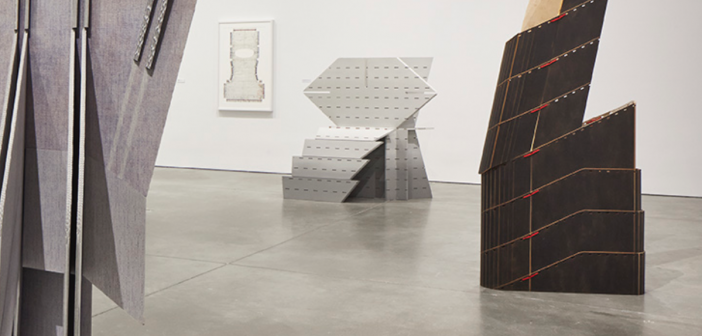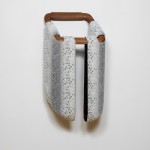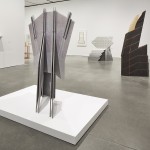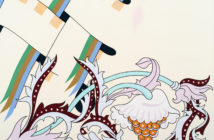In Diane Simpson’s sculptures currently on view at the Institute of Contemporary Art, Boston, the regime of technical drawing collides with the pensile contingency of the textile. To make her sculptures, Simpson subjects the sartorial layer to exacting mathematical study. There is meticulousness to her diagrams and ensuing sculptural translations. Together, they seem to chase after a language or mathematical constancy underlying the history of human dress, what Thomas Carlyle called the “Architectural Idea” behind man (or woman’s) “habilatory endeavors.” But as her calculations proliferate, they lead her to strange results, so that her work seems to share in the skepticism that Carlyle expressed in his 1831 satire Sartor Resartus (The Tailor Retailored) about scientific rationalism’s ability to lead us to greater depths of understanding. Scribbles of math and fractions that run across the diagrams begin to seem like the precision of a fashion industry fit technician run off course toward mad science. Simpson’s sculptures then return to us the surfaces of everyday life in only remotely recognizable form, as though they have had their sense degraded by a game of telephone or one too many runs through a translation app.
One diagram reveals that Simpson derived the form of the sculpture Muff through an analysis of the body’s support for the eponymous garment: the artist apparently abstracted, from a fashion plate that she appends as a collage element, the near-perfect square into which an Elizabethan woman locks her arms to hold a long, draping fur muff away from her body. Simpson then finds correspondence between this shape and the mundane structure of a square towel ring.
The sculpture that results from these returns us the towel ring in mahogany, inflated beyond both its proportions and the body’s, like a comical Claes Oldenburg enlargement or an evocative Robert Gober sink. Though it has attained three-dimensionality, Simpson forces this object to bear the vestiges of its passage through drawing: it juts out from the wall as a rhombus, retaining the drawing’s perspectival skew in one diagonal dimension while embodying the arms’ posture in another. This wooden rhombus provides the armature for two bolts of spotted faux fur that hang down in parallel panels from its front corners in a gesture that can only be described as regal.

Installation view, Diane Simpson, the Institute of Contemporary Art/Boston, 2015–2016. Photo by Charles Mayer.
Sometimes, Simpson will take further derivatives of her objects of study. In Peplum, for instance, a small sculpture made of four planks of curved plywood, she isolates the parergonal structure of what she might call (according to the catalogue) a “nonessential embellishment”–the frilled skirt appended to the lower hem of a shirt or jacket—as a starting point. Simpson then grants her sculptural peplum a skirt of its own: a series of shelves grow out from the small sculpture, functioning as both a base and a skirt for it. In this way, Simpson turns the “peplum” into a deconstructive principle that blurs distinctions and upends hierarchies between essence and accident, ornament and object, sculpture and base. This piece, more than any other, embodies the comment made by Dan Byers, the exhibition’s curator, in his essay, that Simpson’s work makes “a big deal out of the marginal.”
As Simpson vacates these garments of the body, she asks rigid, tectonic materials like wood or plywood to take on not only that absent entity’s supporting function but also its animacy and gesture. These are clothes liberated of function, and so also the need to conform. Simpson’s “garments” tend toward the cylindrical or cuboid, so that inner linings take on equal importance to the outer. Emptied of necks and arms and dilated into tubes, necklines and cuffs open themselves to be looked inside and through. Simpson forces the logic of the garment and the diagram upon one another, revealing how at odds they are in spite of their close intertwinement in fashion production. Where the former conceals and layers, the other pries open and seeks to turn all surfaces toward visibility. See-through mesh shirts and bibs seem to have internalized the logic of the graph paper in their very tissue. The sleeve openings of Formal Wear yawn open so stiffly and expansively that it seems they will emit sound. Simpson forces her sculptures’ inner surfaces toward visibility like so many lapels, or like human tissue clamped open for anatomical study. (This is especially true in Court Lady, which has the feel of a peeled Puryear). They seem to want to present us views of the inside and the outside at once, as though to undermine (in three dimensions) clothing’s concealing function and subject it to perfect perceptibility.
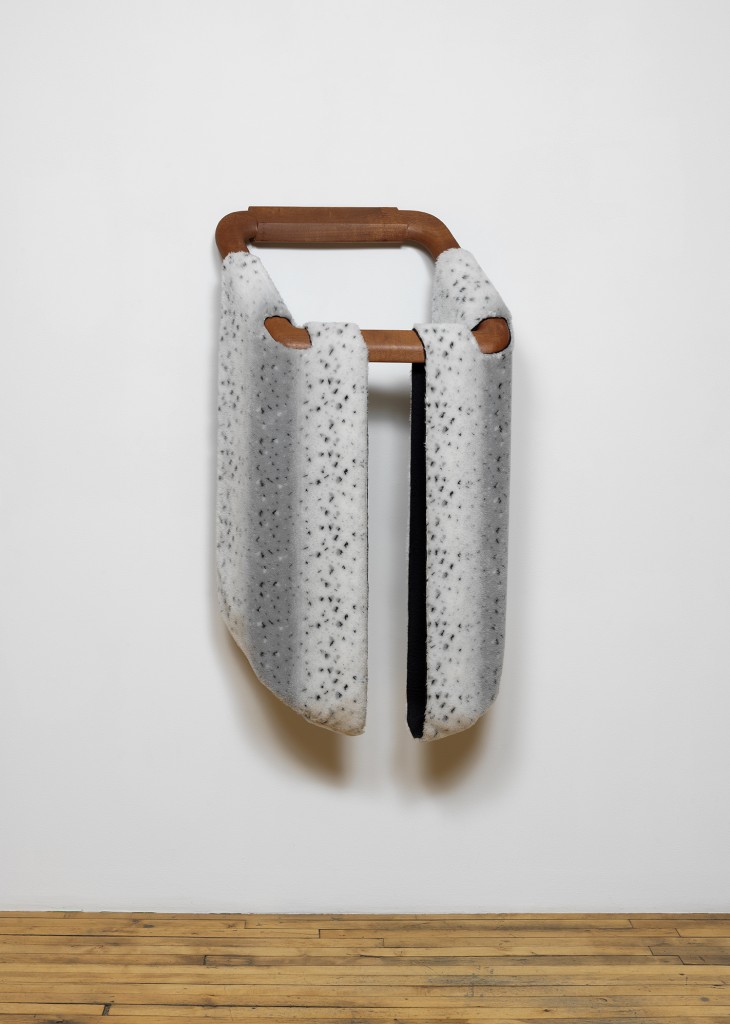
Diane Simpson Muff, 1998 Faux fur, fleece, and mahogany 49 x 28 x 13 inches Collection of Joel Wachs © 2015 Diane Simpson.
At the same time, Simpson presses the textile into the service of graphic values. In Muff, darkened areas on the faux fur make the corners of the fabric appear eerily straight, but also confer on it the perspectival effect of shading. Elsewhere, the artist seems to be using fabric’s drape—the two black ribbons hanging down from her larger-than-life Amish Bonnet, for instance—to divine the plumb line, the draughtsman’s perfect vertical. Everything in the gallery holds its form like a starched shirt; some by virtue of their materials’ inherent rigidity (cardboard, wood, linoleum, or foam), others their draped weight. As Simpson’s creations are pulled toward tautness from above and from below, they create a disorienting sense of buoyancy and weightlessness in the gallery.
Translation between dimensions and materials of the everyday is Simpson’s game—there is virtuosity and cleverness, but also a kind of mad excess in Simpson's continual slips between registers. In Simpson’s world of structure, distinctions become semantic, between a sleeve and a sling for instance. Sleeve-Sling reveals both of these to be looping structures whose difference lies only in the way they carry weight. But in Simpson’s weightless world, free of the body’s contingencies, the arm is beside the point. Here, it is the hat that makes the man.
Put through Simpson’s careful diagramming process, garments and their ornamental details take on the status—the proud posture—of archetypes. In one room, Byers has arranged a series of works bearing the stature and scale of the human torso. Here, Simpson’s expansions and evacuations of the contents of the contemporary department store lend them the uncanny sense of history possessed by the hollow men who populate the galleries of Arms & Armor at the Met. In an interview published in the slim catalogue published in concert with the exhibition, Simpson reveals herself to be a fascinated student of armor. Throughout the works on display, she joins flat plates of rigid materials like an armourer. Three separate planes of linoleum, for instance, form a kind of epaulette around the slender arms of the aquamarine coat hanger in Vest (Scalloped), contributing to the illusion that this rigid material flows downward like fabric.
Pushed far beyond the circumferences of human limbs, necks, and torsos, bibs and aprons appear like the armor of some absent army of women and infants, now equipped for protection from industrial-scale hazards, like radiation or intense heat. "Aprons are Defenses,” Carlyle’s narrator rhapsodized, "against injury to cleanliness, to safety, to modesty, sometimes to roguery….How much has been concealed, how much has been defended in Aprons!” One gets the sense in the galleries of the artist attempting to bring the topography of the everyday—babies’ bibs, aprons, bathroom towel rings—into contact with larger-scale histories of architecture and fashion.
Diane Simpson is on view at the Institute of Contemporary Art, Boston, through March 27, 2016
- Diane Simpson Muff, 1998 Faux fur, fleece, and mahogany 49 x 28 x 13 inches Collection of Joel Wachs © 2015 Diane Simpson.
- Installation view, Diane Simpson, the Institute of Contemporary Art/Boston, 2015–2016. Photo by Charles Mayer.
- Installation view, Diane Simpson, the Institute of Contemporary Art/Boston, 2015–2016. Photo by Charles Mayer.

